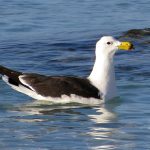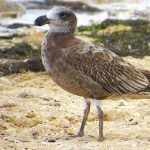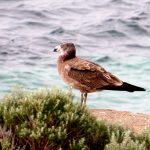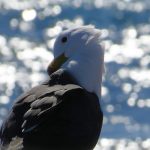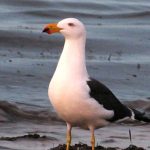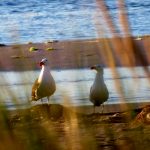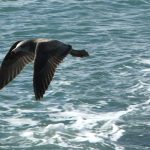PACIFIC GULL
The Pacific gull is a large and impressive seabird, is a resident of the Australian coastline, predominantly found along the southern and western shores of the continent. With its robust build, stark white plumage contrasted by deep black wings, and a bright yellow beak adorned with a striking red tip, the Pacific gull is a sight to behold against the backdrop of Australia’s rugged coastal landscapes.
The lifespan of the Pacific gull is quite remarkable, with these birds often reaching up to 20 years or more in the wild. This longevity is a testament to their resilience and ability to adapt to the dynamic coastal environment.
When it comes to breeding, Pacific gulls are known for their fidelity both to their partner and their chosen nesting sites. The breeding season typically commences around August and extends into November. These gulls prefer to nest in small colonies or, at times, in solitary pairs. Their nests are usually constructed on the ground, crafted with a simple arrangement of vegetation and found materials. They are often located on offshore islands or secluded coastal areas, which provides a degree of protection from predators and human disturbance.
A clutch generally consists of one to three eggs, which are incubated by both parents over a period of about a month. The chicks are nurtured with care, fledging the nest after several more weeks, yet they often remain dependent on their parents for food and guidance for an extended period thereafter.
Pacific gulls are found across the southern coastline, from Western Australia, around the southern tip of the country, and up to southern New South Wales. They are a common sight on beaches, rocky shores, and near coastal towns, where their distinctive calls often fill the air.
One interesting fact about the Pacific gull is its varied diet, which includes a wide range of foods from fish and marine invertebrates to insects and even other seabirds’ young. Their opportunistic feeding habits have allowed them to thrive in diverse coastal environments. They’ve even been observed using their strong beaks to crack open hard-shelled prey like mussels by dropping them onto rocks from a height—a clever tactic indeed!
In terms of conservation, the Pacific gull is currently not considered to be at risk. However, like all wildlife, they face challenges such as habitat loss and pollution. By sharing the story of the Pacific gull and its place along Australia’s beautiful coastlines, we can foster a deeper appreciation for these birds and the vital role they play in the ecosystem, underscoring the importance of protecting the natural habitats that sustain them.

